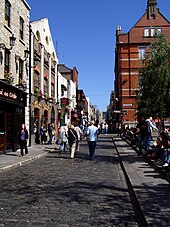Temple Bar (Dublin)
Temple Bar ( Irish Barra an Teampaill ) is a district on the south bank of the River Liffey in central Dublin , Ireland . The neighborhood is enclosed by the River Liffey to the north, Dame Street to the south, Westmoreland Street to the east and Fishamble Street to the west.
In contrast to the surrounding districts, Temple Bar has preserved its early modern streets with many narrow, cobblestone streets. Temple Bar is Dublin's cultural district (especially for tourists ) with a lively nightlife.
history
Temple Bar probably got its name from the Temple family who lived in the area in the 17th century. Sir William Temple, dean of Trinity College Dublin in 1609, lived in his house and garden here. Another possibility of the name origin is the imitation of the Temple Bar district in London . The name 'Temple Bar' first appeared on a map in 1673. On April 13, 1742, Georg Friedrich Handel's oratorio Messiah was premiered in Fishamble Street . An annual demonstration on the same day at the same location is still presented today. In 1791, during a meeting in a tavern on Eustace Street, the Society of United Irishmen , a republican revolutionary movement, was formed.

In the 19th century, the district lost its popularity, in the 20th century the district fell into disrepair and most of the buildings were in ruins. It is possible that the appearance of the quarter saved it from access by real estate dealers who destroyed much of the historic buildings in other parts of Dublin city center in the 1960s. In the 1980s, the state-owned transport company 'Córas Iompair Éireann' planned to purchase the area in order to tear it down and build a bus station on the site. During the planning phase, the buildings were rented out at very reasonable prices, which attracted many small shops, artists and galleries . Protests by 'An Taisce', residents and traders ultimately led to the suspension of the bus station project, and in 1991 the Irish Parliament established the non-profit 'Temple Bar Properties' to oversee the rebuilding of Dublin's cultural district.
present
The neighborhood is home to many Irish cultural institutions such as B. the Irish Photography Center (brings together the Dublin Institute of Photography , the National Photo Archive and the Gallery of Photography ), the Ark Children's Cultural Center , the Irish Film Center with the National Film Archive, the Temple Bar Music Center , the Arthouse Multimedia Center , the Project Arts Center , the Gaiety School of Acting and the Central Bank of Ireland.
After dark, this is where most of Dublin's nightlife takes place, with many tourist-oriented nightclubs, restaurants and pubs, such as: B. Porterhouse , Turk's Head , The Temple Bar , Quays Bar , Foggy Dew , Bad Ass Cafe or The Palace .
Two new squares have been rebuilt in recent years - Meetinghouse Square and Temple Bar Square . The Speaker's Square Project has been taking place at Meetinghouse Square since the summer of 2004 - based on Speaker's Corner in London . Every Saturday at the Meeting House Square of the Temple Bar Food Market and in the Cow's Lane fashion market Cow's Lane Market instead. The Temple Bar Book Market can be found in Temple Bar Square on Saturdays and Sundays.
Web links
Coordinates: 53 ° 20 '44 " N , 6 ° 15' 46" W.



